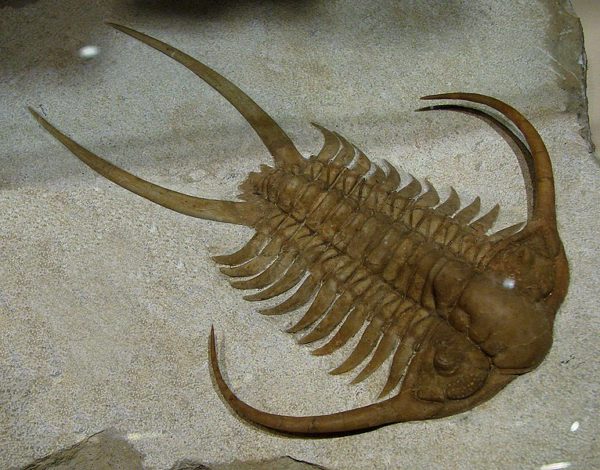Featured image: This is a Trilobite fossil from Volkhov river, Russia. Trilobites were marine arthropods which went extinct at the end of Permian period. CC BY-SA 3.0 via Wikimedia commons
Paper: Bioindicators of severe ocean acidification are absent from the end-Permian mass extinction.
Authors: William J. Foster, J.A. Hirtz, C. Farrell, M. Reistrofer, R. J.Twitchett, R. C. Martindale
What if I told you that an extinction event occurred In Earth’s history that dwarfs the demise of dinosaurs? This turbulent period dawned 252 million years ago, during the Late Permian period. The largest volcanic eruptions in the history of our planet began in now what is known as Siberia. The eruptions spewed out millions of cubic kilometers of lava, enough to bury an area the size of United States under a mile thick layer of rock!
Over two million years, bursts of volcanic activity injected millions of tonnes of greenhouse gases into the atmosphere. Evidence suggests that while making its way up, the magma punched through Permian coal beds and produced tonnes of additional carbon dioxide. The gases altered the composition of the atmosphere and threw the climatic cycle off balance. The temperatures rose by 10˚C (50˚F) making earth inhospitable.
The Siberian Traps (a large region of volcanic rock in Siberia formed by the eruptive episode) are believed to be the main culprit behind the Permian-Triassic mass extinction, largest of the “big five” mass extinction events in Earth’s history. 70% of terrestrial species and 95% of marine organisms went extinct. It was so catastrophic that scientists nicknamed it “The Great Dying”. Marine fauna in the Permian oceans suffered the most during this nightmarish period. Anoxia (lack of oxygen) and ocean acidification from increased carbon dioxide concentrations are believed to be the main kill mechanisms. However, the role of ocean acidification is still unclear. Study of ocean acidification events that occurred in the geological past is very tough. Ocean acidification cycles last for few thousand to tens of thousands of years only. Hence the unavailability of robust proxies has restricted the reach of geoscientists to the Cenozoic, which extends back in time only 66 million years.
The Permian-Triassic ocean acidification event like other similar events, is also controversial. Previously, different geoscientists used different proxies to determine the timing and duration of the event. The results were conflicting and no inference could be drawn from them. Sedimentological proxy indicates that it occurred between late Permian and Permian-Triassic boundary. Boron isotope proxy suggests that ocean acidification didn’t occur at all and that the Permian oceans became alkaline. Foster et al. used a different approach to solve this enigma. Instead of using chemical proxies, they directly studied the fossilized shells of Permian marine creatures. They analyzed the stratigraphic succession of Permian-Triassic age at Lusitaniadalen, Svalbard and tested two hypothesized acidification events; one at the extinction horizon (late Permian) and second at the H.parvus zone (basal Triassic).
Foster and his colleagues analyzed fossils of mollusks–namely bivalves and gastropods–that build their shells from aragonite, or a type of calcium carbonate. Ocean acidification affects the building and maintenance of these shells, as a more acidic ocean makes these shells dissolve more quickly. The authors of this study looked at the shells for repair marks, dissolution scars and morphological deformities. However, they were unable to prove the hypothesized ocean acidification event that occurred at the onset of Permian-Triassic extinction because of lack of shell fossils from that zone. In contrast, the H.parvus zone had well preserved mollusk shells. Dissolution scars found in them are post-mortem. Repair marks which are characteristic evidences of ocean acidification are also absent in these shells. Reduction in size of some brachiopods was reported which indicates acidic conditions but is also caused by anoxia (lack of oxygen). These findings are consistent with fossil assemblages of H.parvus zone in many other locations in the world. Based on these evidences, Foster et al. concluded that the possibility of widespread ocean acidification does not hold water. If acidification had occurred at all, it would have been localized.
The end-Permian mass extinction was a turning point in the story of life. Who knows? We wouldn’t even have existed if not for the end-Permian extinction. Lessons need to be learnt from this apocalyptic episode. Today, we are staring at a 1.5˚C jump in global temperature. Ocean acidification is speeding up. The ecosystem is at a tipping point. The rate at which things are changing today is far more than the changes of past extinction events. We need to act now in order to avoid the same fate as our ancient relatives!
Earth’s darkest hour by Amber Saraf is licensed under a Creative Commons Attribution-ShareAlike 4.0 International License.

